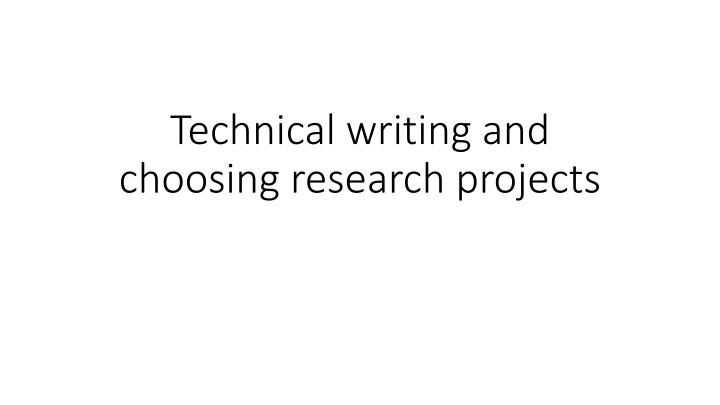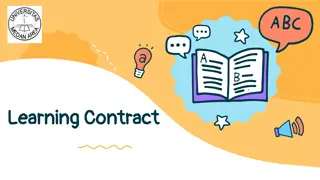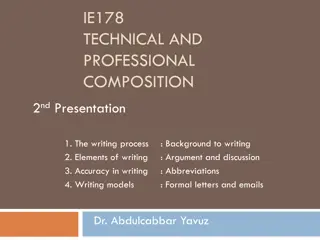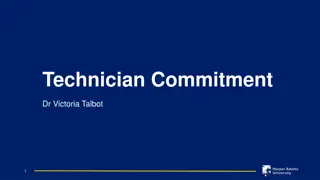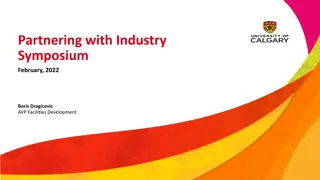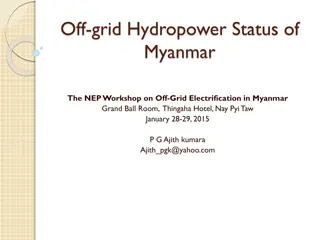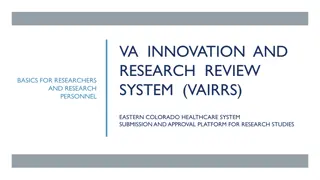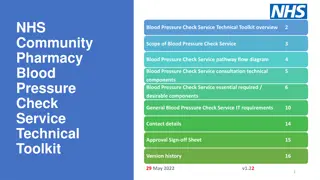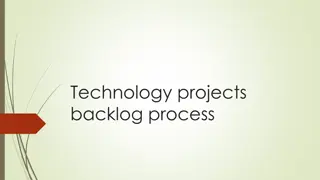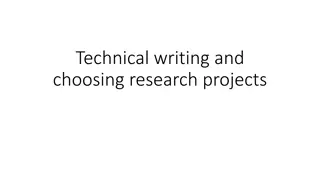Technical writing and choosing research projects
Writing and choosing research projects involves technical writing skills, effective communication strategies, and clear project selection criteria. The key is to convey information in a concrete and precise manner, minimizing unnecessary jargon to ensure clarity and understanding. The Heilmeier Catechism and problem statement frameworks can guide researchers in articulating objectives, defining problems, and assessing potential impacts. By focusing on specific objectives and addressing challenges with innovative approaches, researchers can enhance project success and make a meaningful difference in their respective fields.
Download Presentation

Please find below an Image/Link to download the presentation.
The content on the website is provided AS IS for your information and personal use only. It may not be sold, licensed, or shared on other websites without obtaining consent from the author.If you encounter any issues during the download, it is possible that the publisher has removed the file from their server.
You are allowed to download the files provided on this website for personal or commercial use, subject to the condition that they are used lawfully. All files are the property of their respective owners.
The content on the website is provided AS IS for your information and personal use only. It may not be sold, licensed, or shared on other websites without obtaining consent from the author.
E N D
Presentation Transcript
Technical writing and choosing research projects
Writing and speaking Taylor talk / paper to audience Maximize the amount of information conveyed Be as concrete and precise as possible Minimize jargon: aim is to communicate, not to sound eloquent or smart. First drafts always contain frivolous words Way harder to write less and not more.
Nervous, yes, very, very nervous I am and always was, but why will you say I am mad?
Heilmeier Catechism What are you trying to do? Articulate your objectives using absolutely no jargon. What is the problem? Why is it hard? How is it done today, and what are the limits of current practice? What's new in your approach and why do you think it will be successful? Who cares? If you're successful, what difference will it make? What impact will success have? How will it be measured? What are the risks and the payoffs? How much will it cost? How long will it take? What are the midterm and final "exams" to check for success? How will progress be measured?
The problem statement What are you trying to do? Articulate your objectives using absolutely no jargon. What is the problem? Why is it hard? How is it done today, and what are the limits of current practice? What's new in your approach and why do you think it will be successful? Who cares? If you're successful, what difference will it make? What impact will success have? How will it be measured? What are the risks and the payoffs? How much will it cost? How long will it take? What are the midterm and final "exams" to check for success? How will progress be measured?
The problem statement Bad: I want to do low-shot learning Good: I want to learn image classifiers for new categories using very little labeled data Jargon = You haven t thought about it enough
The problem statement Problem is separate from approach Bad: I want to use GANs for object detection. Good: I want to improve the ability to detect objects in unusual images.
The problem statement Problem should be concrete (given time-frame) What are the inputs and outputs? Very bad: I want to improve computer vision. Bad: I want to recognize objects in images . Good: Given an image, I want to identify which object categories are present in it.
The problem statement Which visual elements of a design increase memory for the design and which increase liking for it? Are these elements the same, or different and what is the relationship between remembering and liking? (Meredith Hu)
The problem statement Our problem therefore is twofold: We want to be able to identify if an object is passing to the left or the right of our agent. We want to measure the impact of incorporating synthetic data with real world data on accuracy in the domain of this problem. (Claire Liang, Abigail Schur)
Related work and your work What are you trying to do? Articulate your objectives using absolutely no jargon. What is the problem? Why is it hard? How is it done today, and what are the limits of current practice? What's new in your approach and why do you think it will be successful? Who cares? If you're successful, what difference will it make? What impact will success have? How will it be measured? What are the risks and the payoffs? How much will it cost? How long will it take? What are the midterm and final "exams" to check for success? How will progress be measured?
Related work and your work Related work should not be just a listing of past work Related work should place your work in context of past work Where did prior work fall short? They tackled a different problem: why is your statement more worthwhile? They did not use a particular cue/constraint: why is this cue useful / important? The experiments were lacking: how and what will you do instead?
Describing your approach Be concrete! Bad: We use GANs and non-parametric Bayesian models for semantic segmentation
Describing your approach F-matrix representation: We can use a normalized 3x3 matrix to represent the F-matrix. It is a rank 2 homogeneous matrix with 7 degrees of freedom. The F-matrix can also be represented by two epipoles and one more element, or it can be represented by a set of keypoint correspondences. - Guandao Yang, Qiuren Fang, Hanqing Jiang
Evaluation and experimentation What are you trying to do? Articulate your objectives using absolutely no jargon. What is the problem? Why is it hard? How is it done today, and what are the limits of current practice? What's new in your approach and why do you think it will be successful? Who cares? If you're successful, what difference will it make? What impact will success have? How will it be measured? What are the risks and the payoffs? How much will it cost? How long will it take? What are the midterm and final "exams" to check for success? How will progress be measured?
Evaluation and experimentation Ideally, falls naturally from concrete problem definition Ideally, should be designed early A bad evaluation protocol does irreparable damage
Evaluation and experimentation Baselines Prior work that tackles the same problem (e.g., previous state-of-the-art) Oracles A version of your approach that has access to some privileged information / extra resources Ablations A version of your approach with some features removed
